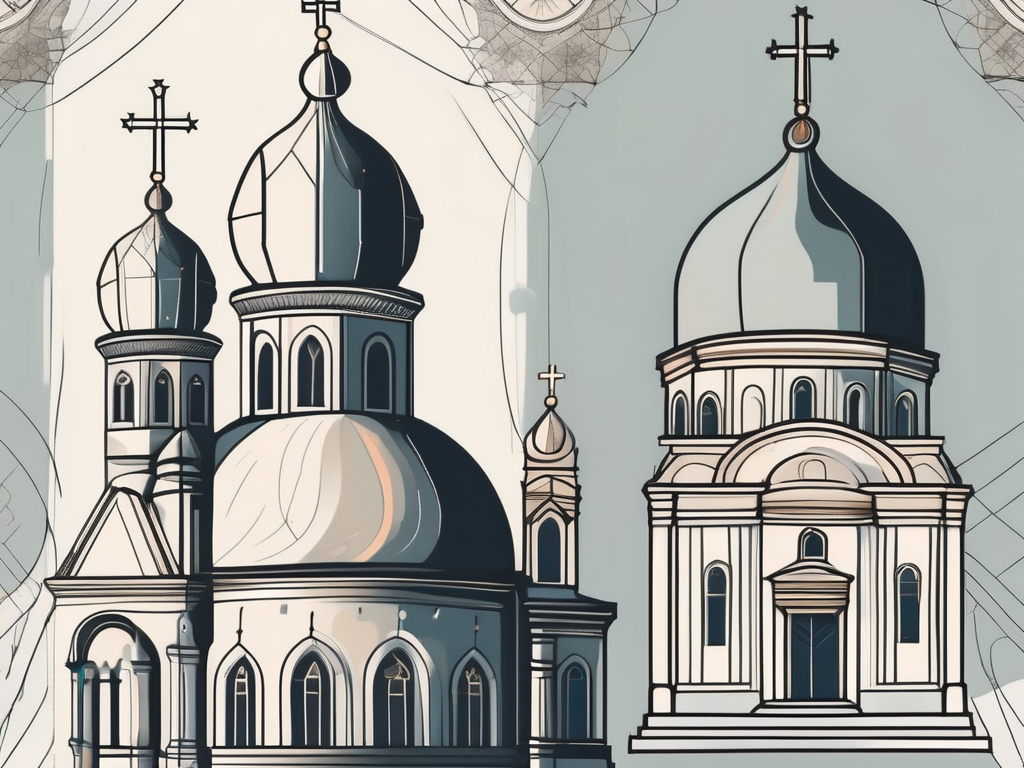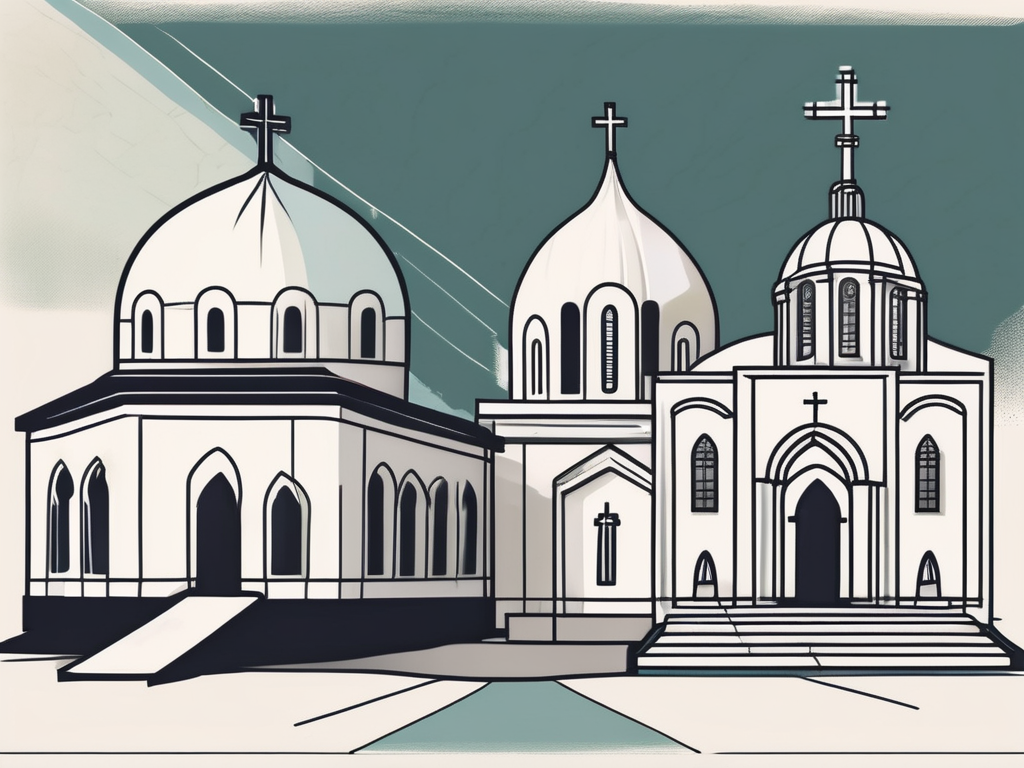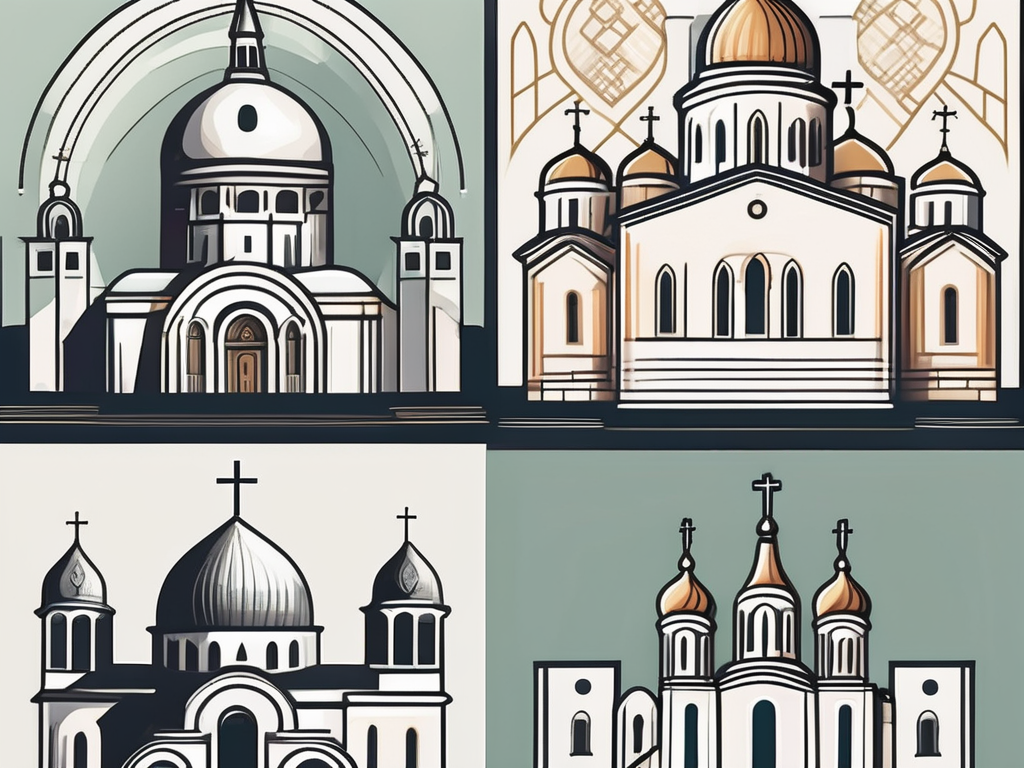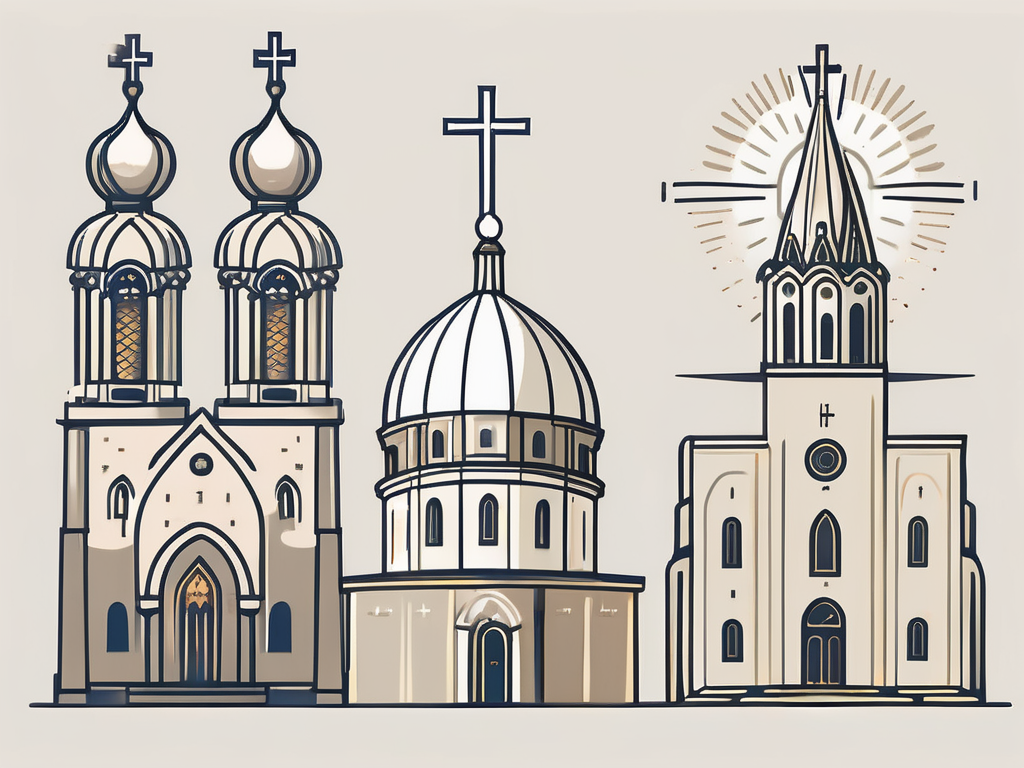In the world of Christianity, two prominent branches stand out: Catholicism and Eastern Orthodoxy. While both share common roots, they have evolved into distinct religious entities over the centuries. In this article, we will delve into the similarities and differences between these two fascinating branches, exploring their historical backgrounds, key beliefs, theological variations, liturgical practices, sociopolitical impacts, and efforts towards reconciliation.
Understanding the Catholic and Eastern Orthodox Churches
Origins and Historical Background
The Catholic Church traces its origins back to the teachings of Jesus Christ and his apostles, with St. Peter being recognized as the first Pope. It gradually spread across the Roman Empire, playing a significant role in shaping Western civilization. The early Christians faced persecution from the Roman authorities, but they remained steadfast in their faith and continued to spread the message of Christ.
During the fourth century, Emperor Constantine legalized Christianity, leading to its rapid growth and influence. The Catholic Church became the official religion of the Roman Empire, and its bishops gained considerable power and authority. However, as the empire began to decline, the Church faced numerous challenges, including invasions by barbarian tribes and internal conflicts.
Meanwhile, Eastern Orthodoxy emerged from the Byzantine Empire, which was the eastern half of the Roman Empire that survived after the fall of the West. The Byzantine Empire had a rich cultural and religious heritage, blending elements of Greek, Roman, and Christian traditions. The Eastern Orthodox Church developed its distinct identity, influenced by the Byzantine culture and the teachings of the early Church fathers.
The East-West Schism in 1054 marked the formal split between Catholicism and Orthodoxy. The primary cause of the schism was the disagreement over the authority of the Pope and the insertion of the Filioque clause into the Nicene Creed. This event had a profound impact on the religious, political, and cultural landscape of Europe, leading to centuries of division and tension between the Catholic and Eastern Orthodox Churches.
Key Beliefs and Practices
Both Catholicism and Eastern Orthodoxy uphold the authority of Scripture, believe in the Holy Trinity, and regard Jesus Christ as the Son of God. However, there are some differences in their beliefs and practices that have developed over the centuries.
Catholics acknowledge the supremacy of the Pope, who is considered the successor of St. Peter and the Vicar of Christ on Earth. The Pope has the authority to make infallible pronouncements on matters of faith and morals. This centralized structure allows for a unified doctrine and decision-making process within the Catholic Church.
On the other hand, Eastern Orthodox churches embrace a more decentralized structure with no single leader. Instead, they have a collective leadership known as the Holy Synod, consisting of bishops from different regions. Each bishop has autonomy over his diocese and is responsible for the spiritual guidance of his flock.
Another significant difference lies in the liturgical practices. Catholic Mass is typically celebrated in Latin, although vernacular languages are now widely used. The Eucharist, also known as Holy Communion, is a central sacrament in Catholicism. The Eastern Orthodox Church, on the other hand, celebrates the Divine Liturgy in various ancient languages, such as Greek, Slavonic, or Arabic, depending on the region. The Eucharist holds a similar importance in the Eastern Orthodox tradition, seen as the mystical participation in the body and blood of Christ.
Both Catholicism and Eastern Orthodoxy place a strong emphasis on the veneration of saints and the use of icons in worship. However, the approach to these practices differs slightly. Catholics often seek the intercession of saints and view their relics as sacred objects. In contrast, Eastern Orthodox Christians believe that icons are windows to the divine and serve as aids to prayer and contemplation.
Despite their differences, both Catholicism and Eastern Orthodoxy share a rich spiritual heritage and continue to play significant roles in the lives of their followers. The Catholic Church remains the largest Christian denomination, with a global presence, while Eastern Orthodoxy has a strong presence in Eastern Europe, Russia, and parts of the Middle East.
Theological Differences between Catholic and Eastern Orthodox Churches
The theological differences between the Catholic Church and the Eastern Orthodox Church are complex and multifaceted, encompassing various aspects of doctrine, tradition, and ecclesiology. Understanding these differences requires a deep dive into the historical and theological developments that have shaped these two distinct branches of Christianity.
Views on the Papacy
One of the primary theological rifts between Catholicism and Eastern Orthodoxy lies in their understanding of the papacy. Catholics view the Pope as the successor of St. Peter, the first among the apostles, and believe that he possesses infallibility in matters of doctrine and moral teachings. This belief is rooted in the Catholic doctrine of papal primacy, which asserts that the Pope has the authority to make infallible pronouncements on matters of faith and morals.
In contrast, Eastern Orthodox churches uphold the concept of “first among equals,” recognizing the Patriarch of Constantinople as the primus inter pares, rather than granting any infallible authority to him. The Eastern Orthodox Church operates under a conciliar model of governance, where decisions are made collectively by bishops in council, rather than being centralized in the office of the Pope.
This difference in understanding the role of the Pope has been a significant point of contention between the two branches of Christianity throughout history. It has played a crucial role in the schism between the Catholic Church and the Eastern Orthodox Church, which occurred in 1054 and remains unresolved to this day.
Understanding of the Holy Trinity
Regarding the Holy Trinity, both Catholicism and Eastern Orthodoxy share the belief in God the Father, Jesus Christ the Son, and the Holy Spirit. However, there is a nuanced difference in the understanding of the procession of the Holy Spirit.
Catholics emphasize the concept of the Filioque, which asserts that the Holy Spirit proceeds from both the Father and the Son. This addition to the Nicene Creed, which was made in the Western Church during the medieval period, has been a subject of disagreement between the Catholic Church and the Eastern Orthodox Church. Eastern Orthodox Christians argue that the Holy Spirit proceeds solely from the Father, and they view the inclusion of the Filioque as an unauthorized alteration of the Creed.
This theological difference has been a significant point of contention between the two branches, contributing to the schism and ongoing divisions between Catholicism and Eastern Orthodoxy.
Approach to Sacraments
While both Catholicism and Eastern Orthodoxy recognize seven sacraments, the emphasis placed on each sacrament differs between the two traditions.
Catholics have a more systematic approach to sacraments, with the Eucharist (Holy Communion) at the heart of their worship. The Catholic Church teaches that the Eucharist is the real presence of Jesus Christ, and the faithful are called to partake in this sacrament as a means of receiving grace and nourishment for their spiritual journey. The celebration of the Eucharist is central to Catholic liturgy and is considered the source and summit of the Christian life.
On the other hand, Eastern Orthodox Christians regard all sacraments as essential for spiritual growth and salvation. They place particular importance on the sacrament of Confession or Repentance, also known as Penance or Reconciliation. In the Eastern Orthodox tradition, Confession is seen as a sacrament of healing and reconciliation with God and the Church. It is a deeply personal and transformative experience that allows the faithful to confess their sins, receive absolution, and seek spiritual guidance from their spiritual father or confessor.
While the sacraments are celebrated and understood differently in Catholicism and Eastern Orthodoxy, both traditions recognize their significance in nurturing the spiritual life of the faithful and fostering a deeper relationship with God.
In conclusion, the theological differences between the Catholic Church and the Eastern Orthodox Church are profound and have shaped the distinct identities of these two branches of Christianity. The views on the papacy, the understanding of the Holy Trinity, and the approach to sacraments are just a few examples of the theological divergences that have contributed to the historical and ongoing separation between Catholicism and Eastern Orthodoxy.
Liturgical Variations
Structure of Worship Services
The liturgical practices in Catholicism and Eastern Orthodoxy display variations in structure and formality. Catholic Masses often follow a consistent structure, with a set liturgy and specific prayers. The structure of the Mass is designed to guide the faithful through a journey of worship, reflection, and communion with God. It begins with the introductory rites, which include the entrance procession, the sign of the cross, and the penitential rite. This is followed by the Liturgy of the Word, where readings from the Old and New Testaments are proclaimed, and a homily is delivered to provide spiritual guidance and insight. The Liturgy of the Eucharist is the central part of the Mass, where the bread and wine are consecrated and transformed into the body and blood of Christ. Finally, the Mass concludes with the concluding rites, which include the final blessing and dismissal.
On the other hand, Eastern Orthodox worship services, known as Divine Liturgy, feature intricate rituals, vibrant chants, and extensive use of icons. The Divine Liturgy is a deeply symbolic and mystical experience, aiming to transport the worshipper into the heavenly realm. The service is divided into different sections, each with its own unique significance. The Proskomedia, or the preparation of the gifts, takes place before the Divine Liturgy begins. This is where the bread and wine are prepared and placed on the altar. The Liturgy of the Catechumens follows, where the faithful participate in the readings and prayers. The climax of the Divine Liturgy is the Liturgy of the Faithful, where the Eucharist is consecrated and distributed to the worshippers. Throughout the service, the congregation is immersed in beautiful chants, sung by the choir and the congregation, creating a sense of awe and reverence.
Iconography and Symbolism
Iconography holds a significant place in Eastern Orthodox traditions, serving as windows to the divine. Icons, depicting Christ, the Virgin Mary, and numerous saints, are venerated during worship and play a vital role in invoking spiritual connections. These sacred images are believed to be more than mere representations; they are seen as channels of divine grace and presence. The use of icons in Eastern Orthodox worship is deeply rooted in the belief that the divine can be encountered through the material world. The faithful approach icons with reverence, kissing them and offering prayers, seeking intercession and spiritual guidance.
In contrast, while Catholicism also employs icons, their use is generally less pronounced. Catholic churches often have statues and images of saints, but they do not hold the same level of veneration as icons in Eastern Orthodoxy. The focus in Catholic worship is more on the sacraments, particularly the Eucharist, as the central means of encountering the divine. However, icons still hold a significant place in Catholic spirituality, serving as visual reminders of the presence of Christ and the saints. They are often used as aids for personal devotion and meditation, inviting the faithful to contemplate the mysteries of the faith.
Sociopolitical Impacts of the Schism
Influence on Eastern and Western Civilizations
The East-West Schism had a profound impact on both Eastern and Western civilizations. The division contributed to the religious and cultural divergence between the two regions. Catholicism became closely intertwined with European history, while Eastern Orthodoxy played a significant role in shaping the Byzantine Empire and later became central to the identity of nations like Greece, Russia, and Serbia.
Role in Global Christianity Today
Currently, the Catholic Church is the largest Christian denomination worldwide, with a vast following spread across different continents. Eastern Orthodoxy, though smaller in numbers, has a strong presence in Eastern Europe and still carries immense cultural and religious significance. Both branches continue to shape global Christianity, promoting their respective traditions and engaging in dialogue with other Christian denominations.
Efforts Towards Reconciliation
Ecumenical Dialogues and Initiatives
In recent decades, efforts towards reconciliation between Catholicism and Eastern Orthodoxy have gained momentum. Ecumenical dialogues have taken place, aimed at fostering understanding, and identifying common ground. These initiatives have sought to bridge theological gaps that have kept the two branches apart for centuries.
Challenges and Prospects for Unity
Although progress has been made, challenges remain on the path to unity. The theological differences, centuries-old divisions, and the complex historical baggage create obstacles to reconciliation. Nonetheless, through patient dialogue, mutual respect, and an open spirit, there is hope for eventual unity, enabling Catholics and Eastern Orthodox Christians to celebrate their shared faith while respecting their distinctive traditions.
In conclusion, a comparative analysis of Catholicism and Eastern Orthodoxy reveals both shared heritage and intriguing distinctions. Their historical backgrounds, theological variations, liturgical practices, sociopolitical impacts, and ongoing efforts towards reconciliation contribute to their rich tapestry within the diverse world of Christianity. Exploring these branches not only deepens our understanding but also invites us to appreciate the beauty and complexity of religious diversity.












